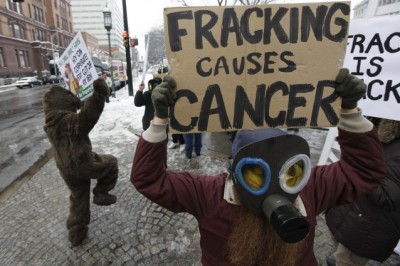I recently drove through Oklahoma, a hot spot for hydraulic fracturing, or fracking. This highly controversial practice used by the “natural gas” industry is old news by now—but it’s easy to forget just how sad and devastating it really is.
I drove through a land scarred by oil well sites—over 32,000 at last count (nearly 3,000 of which are being actively fracked). Pastoral landscapes and old farmhouses now seem less prevalent than industrial lots filled with fracking equipment. The parking lot of the hotel where I stayed was packed to the gills with natural gas company trucks, and the strong smell of methane hung in the air.
I spent a total of about sixteen hours in this heart of fracking country, and during that time, the county experienced sixteen earthquakes. And this earthquake-per-hour phenomenon was not an anomaly—the area had already experienced seventy earthquakes just that week, and it appears that they’re worsening in strength and frequency.
To top it all off, I took a brief shower in the morning, and within minutes had a rash over most of my body which took a good part of the day to fade.
It simply floors me that anyone could think that fracking is an acceptable practice—especially given the overwhelming body of evidence to the contrary.
The ill effects of fracking—including ground water pollution, air pollution, and destabilization of seismic faults—are very well-known (or at least suspected) even in mainstream circles. Nevertheless, the oil and natural gas companies have previously been able to maintain plausible deniability, simply because they’re allowed to keep their proprietary slurry of fracking chemicals a relative secret, and because no officially validated research has ever been conducted to demonstrate the harmful fallout of fracking.
But this is all changing. Recently, a study was published in Toxicology and Applied Pharmacology that demonstrates something we all suspected: fracking wastewater can cause cancer.
Finally, hard evidence of fracking’s destructive effects on our health
In the very first official study of its kind, teams of scientists in both the U.S. and China analyzed “flow back” water from hydraulic fracturing sites, and found an abundance of toxic materials, including barium, strontium, methane, and other known toxins.[1] Another study, which focused on testing flow back water for radioactive materials, also found radium, polonium, and lead, all of which are decay products of uranium and thorium.[2]
Researchers fear that fracking releases radioactive materials that would normally remain locked away deep in the earth—these radioisotopes then get added to the already toxic slurry of ingredients that comprise fracking flow back water.
The presence of such horrendous toxins would explain why researchers found that flow back water “induces malignant changes in human bronchial cells.” When this same water was injected into mice, a whopping 83% of them developed cancerous tumors within three months.[3]
The researchers’ conclusion was unambiguous: the flow back water from fracking, which almost inevitably pollutes drinking water in areas of high fracking activity, can cause cancer in humans.
While any number of the toxins in flow back water could be carcinogenic—after all, the EPA acknowledges that there are “thousands of chemicals” in fracking fluid—this study identified barium and strontium as the main offenders. Both of these substances mimic calcium, and thus are readily absorbed by the cells in your body.
These findings represent a huge step forward. The hope is that such evidence can be used to make natural gas companies take responsibility for their health-destroying practices—and better yet, to have fracking banned outright.
But the battle is far from over
While this study is a milestone in the fight against fracking, it’s going to take a lot more to slow the progress of natural gas companies.
Even as states like New York enact moratoriums on fracking, others continue to allow its expansion, seduced by the prospect of jobs and economic growth. Natural gas companies have even begun to sell their cancer-causing wastewater back to California farmers, stating that they’re “doing their part” to help the drought-stricken state (in reality, they’ve simply found a way to make money off their waste rather than paying to dispose of it properly).[4]
None of us should stand for this gross mistreatment of our country’s land and endangerment of our health. Without a massive grassroots resistance, fracking is not going to stop. And it all starts with education. If you haven’t done so already, be sure to watch this excellent documentary on the horrors of fracking…
Learn about whether fracking is going on in your area, and get involved in anti-fracking campaigns in whatever way feels comfortable for you.
Much of the world is already convinced that fracking simply shouldn’t be considered as an option for resource extraction—only by coming together and showing that we won’t tolerate it can we hope to rid the United States of this heinous practice too.
- Ryan Greendyk a professional health journalist and writer from Santa Fe, NM. Yoga teacher and meditator, he is most passionate about helping others discover the gift of of holistic health, teaching others how to take responsibility for their own health and changing the World.
References
[1] http://www.sciencedirect.com/science/article/pii/S0041008X15300375
[2] http://www.ncbi.nlm.nih.gov/pmc/articles/PMC4492256/
[3] http://www.sciencedirect.com/science/article/pii/S0041008X15300375
[4] http://fuelfix.com/blog/2015/07/09/california-farms-are-using-fracking-wastewater-to-grow-crops/#2572101=0






